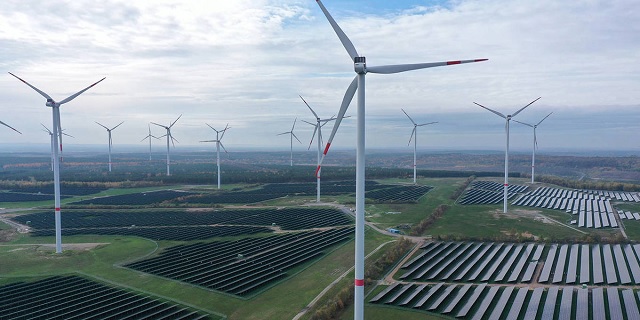
Striking the right balance between public intervention and reliance on market forces is crucial
COMMENT | ARMOND COHEN, ANDREAS GOLDTHAU & SIMONE TAGLIAPIETRA | As Western governments face the increasingly urgent task of accelerating the transition to a low-carbon economy, the pendulum has swung away from a heavy reliance on markets to drive innovation toward state intervention. Fearing China’s dominance in clean-tech supply chains, and recognising the potential for job creation, the United States has put in place a wide range of industrial policies that support the development and deployment of green solutions.
For example, the U.S. Inflation Reduction Act openly encourages reshoring by offering generous government support for firms building green-manufacturing capacity in the country. Following suit, the European Union’s Net-Zero Industry Act introduces a domestic clean-tech manufacturing target, marking a paradigm shift in Europe’s approach to economic governance.
But striking the right balance between the public and private sectors will be crucial to managing the clean-energy transition in an efficient and timely manner and avoiding any backlash against climate goals.
Energy markets, in their current form, have clearly failed to accelerate the deployment of green technologies with sufficient scale and speed. In the absence of reforms or supplemental policies, they will continue to promote the cheapest power available, which until recently meant fossil fuels in most places. Given this, it is not surprising that governments are revisiting industrial policy which has proven successful in the past to spur investment in clean technologies. Moreover, the massive amount of new infrastructure required for clean-energy generation, storage, and distribution may compel the state to implement better permitting processes and to take a more proactive planning role.
But government intervention in the clean-energy transition also carries risks. Picking winners in green technologies or projects may lead to investment decisions that are costly or economically ineffective outcomes that partly drove the pro-market energy-sector reforms of recent decades.
Moreover, the risk of state capture a serious problem with fossil-fuel industries also exists in the renewables domain. Pervasive lobbying efforts, coupled with a lack of accountability and transparency, could result in suboptimal resource allocation. Through green industrial policies, governments essentially create rent-seeking opportunities, which tend to be more pronounced in systems with low institutional quality (as indicated by government effectiveness, legal security, bureaucratic quality, corruption, the regulatory environment, and other related measures).
The specter of “nationalist” climate bills fragmenting global clean-tech supply chains also looms. It was the spontaneous and uncoordinated international division of labour between the United States (innovation), Europe (subsidies and grants for installation), and China (manufacturing efficiencies through economies of scale) that rapidly drove down the price of solar panels and led to their global deployment. Forceful reshoring may therefore slow the pace of the energy transition worldwide.
Striking the right balance between public intervention and reliance on market forces is crucial to move forward. To ensure that state and market are partners in developing and deploying green solutions, policymakers must take three steps. For starters, governments should focus on boosting breakthrough innovations for decarbonisation. That means providing public funding for fundamental research and creating stronger incentives for firm-level innovation through carbon pricing, tax credits, and environmental regulations. The state should also support the piloting, demonstration, and early deployment of emerging clean technologies to demonstrate technical performance and reduce costs to the point of competitiveness with fossil fuels.
Second, the state has an important role to play in nudging and steering large-scale private investment in green solutions through a range of policy interventions, including clean-energy standards, technology-specific tax incentives, government-directed procurement, and carbon pricing. At the same time, public support is crucial for lowering the cost of capital for clean-energy projects, ensuring their social acceptance, and providing the so-called “enabling investments” that are a prerequisite for private-sector participation. Direct public involvement in the development, ownership, or operation of mature technologies such as electricity transmission could also be appropriate in some cases to speed up development and drive down costs.
Finally, governments design markets, as well as their underlying institutional framework, which means that the state must plan energy systems in such a way that they help create the conditions needed to achieve climate goals. Ambitious and reliable pathways to net-zero emissions should be combined with flexible energy-market regulations aimed at establishing effective incentives to mobilise private capital and to deploy clean-energy technologies at scale.
The transition from unabated fossil fuels to zero-carbon energy amounts to an industrial revolution, albeit with the pressure of a firm deadline. Not only is time running out, but policy decisions will need to be taken against a backdrop of volatile global energy markets, lingering public concerns about certain green technologies, and intensifying geopolitical tensions, most notably between China and the West.
Given these uncertainties, policymakers must be willing to take risks in creating incentives for clean-tech innovation, in promoting investment in the development and deployment of these technologies, and in designing energy markets. But they should also remember that the state and market need to be partners, and the green transition will inevitably and increasingly create complex trade-offs that must be navigated carefully; otherwise, the clean-energy future will remain out of reach.
*****

This commentary is also signed by Bruce Phillips, Senior Adviser at the NorthBridge Group.
Armond Cohen is Executive Director of the Clean Air Task Force. Andreas Goldthau is Director of the School of Public Policy at the University of Erfurt. Simone Tagliapietra is a senior fellow at Bruegel.
Copyright: Project Syndicate, 2023.
 The Independent Uganda: You get the Truth we Pay the Price
The Independent Uganda: You get the Truth we Pay the Price


